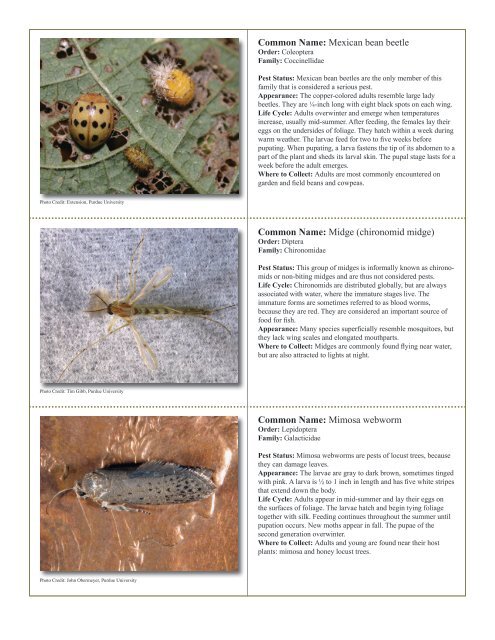to download pdf - Purdue Extension Entomology - Purdue University
to download pdf - Purdue Extension Entomology - Purdue University
to download pdf - Purdue Extension Entomology - Purdue University
You also want an ePaper? Increase the reach of your titles
YUMPU automatically turns print PDFs into web optimized ePapers that Google loves.
Common Name: Mexican bean beetle<br />
Order: Coleoptera<br />
Family: Coccinellidae<br />
Pest Status: Mexican bean beetles are the only member of this<br />
family that is considered a serious pest.<br />
Appearance: The copper-colored adults resemble large lady<br />
beetles. They are ¼-inch long with eight black spots on each wing.<br />
Life Cycle: Adults overwinter and emerge when temperatures<br />
increase, usually mid-summer. After feeding, the females lay their<br />
eggs on the undersides of foliage. They hatch within a week during<br />
warm weather. The larvae feed for two <strong>to</strong> five weeks before<br />
pupating. When pupating, a larva fastens the tip of its abdomen <strong>to</strong> a<br />
part of the plant and sheds its larval skin. The pupal stage lasts for a<br />
week before the adult emerges.<br />
Where <strong>to</strong> Collect: Adults are most commonly encountered on<br />
garden and field beans and cowpeas.<br />
Pho<strong>to</strong> Credit: <strong>Extension</strong>, <strong>Purdue</strong> <strong>University</strong><br />
Common Name: Midge (chironomid midge)<br />
Order: Diptera<br />
Family: Chironomidae<br />
Pest Status: This group of midges is informally known as chironomids<br />
or non-biting midges and are thus not considered pests.<br />
Life Cycle: Chironomids are distributed globally, but are always<br />
associated with water, where the immature stages live. The<br />
immature forms are sometimes referred <strong>to</strong> as blood worms,<br />
because they are red. They are considered an important source of<br />
food for fish.<br />
Appearance: Many species superficially resemble mosqui<strong>to</strong>es, but<br />
they lack wing scales and elongated mouthparts.<br />
Where <strong>to</strong> Collect: Midges are commonly found flying near water,<br />
but are also attracted <strong>to</strong> lights at night.<br />
Pho<strong>to</strong> Credit: Tim Gibb, <strong>Purdue</strong> <strong>University</strong><br />
Common Name: Mimosa webworm<br />
Order: Lepidoptera<br />
Family: Galacticidae<br />
Pest Status: Mimosa webworms are pests of locust trees, because<br />
they can damage leaves.<br />
Appearance: The larvae are gray <strong>to</strong> dark brown, sometimes tinged<br />
with pink. A larva is ½ <strong>to</strong> 1 inch in length and has five white stripes<br />
that extend down the body.<br />
Life Cycle: Adults appear in mid-summer and lay their eggs on<br />
the surfaces of foliage. The larvae hatch and begin tying foliage<br />
<strong>to</strong>gether with silk. Feeding continues throughout the summer until<br />
pupation occurs. New moths appear in fall. The pupae of the<br />
second generation overwinter.<br />
Where <strong>to</strong> Collect: Adults and young are found near their host<br />
plants: mimosa and honey locust trees.<br />
Pho<strong>to</strong> Credit: John Obermeyer, <strong>Purdue</strong> <strong>University</strong>
















